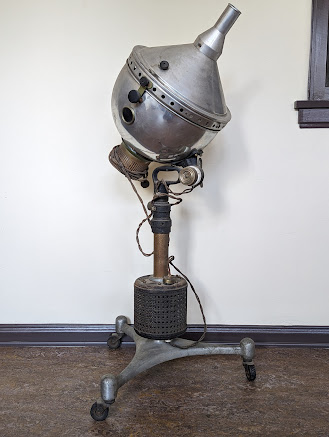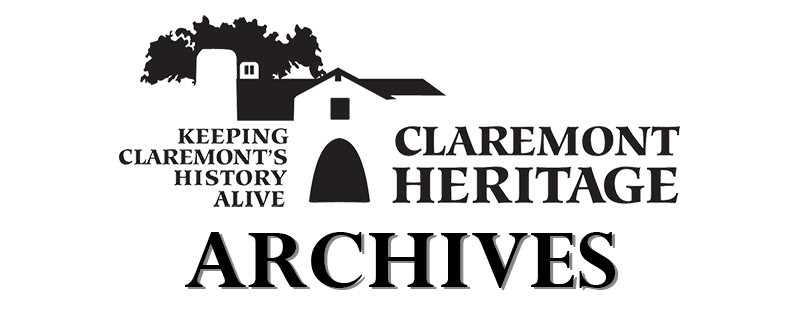A History of Claremont in 100 Objects Blog Series #1 “Radiant Therapy Machine”-Mary Garner Hirsch Collection
#1 “Radiant Therapy Machine”-Mary Garner Hirsch Collection
by Cooper Crane
This is a story about light, medicine, a Nobel Prize winner,
and the body. This is a story about how
we view our bodies, and how we negotiate and reshape our bodies and physical
self. This is a story about heliotherapy.
One of the more interesting objects in the Garner House is
a strange metallic lamp. Made from a dull nickel, the metal shell is shaped
almost like a decanter with a protruding funnel at one end. Standing about
three feet in height, it is curiously out of place with many of the other items
on display in the house. So, what is this strange object?
 |
| Heliotherapy lamp at Garner House, Claremont Heritage |
I write this post sitting next to the lamp, in the same way
a person would have done using the device in the early 20th century.
This particular lamp was part of the Garner family’s own daily lives. Our lamp
was donated by Mary Garner Hirsch, granddaughter of Herman and Bess Garner, who built
the Garner House.
 |
| Carbon Arc Lamp, Paul E. Johnson Company catalog (1925) |
The lamp was built by the Paul E. Johnson Company, but
there were many other companies who built similar devices. The builders’ plaque
prominently displays, “Paul E. Johnson, Universal Therapeutic Lamps, Chicago.” The
company advertised and sold models of lamps including Mercury Quartz, Carbon
Arc, among others. Our lamp is an infrared model.
 |
| Paul E. Johnson Company logo |
These lamps collectively were known as heliotherapy lamps
and were first brought into use by Faroese-Danish physician Niels Finsen.
Finsen had observed that specific forms of ultra-violet light were effective in
treatment. He observed that exposure to UV light cause the destruction of Lupus
vulgaris, a disease related to tuberculosis. Finsen called this treatment
“heliotherapy” or therapy of the sun. For his efforts, Finsen was awarded the
Nobel Prize, and his heliotherapy patents entered into medicine as a respected
and important tool for early 20th century doctors and clinicians.
 |
| Niels Finsen |
Early heliotherapy treatments called for exposure to direct sunlight. This meant regular sunbathing, and because exposure was dependent on exposure of the highest amount of surface area possible this sometimes meant nudity for individual patients. But exposure to the sun was dependent on its availability. At higher latitudes, in the winter seasons, or in periods of inclement weather this was not an option. Additionally, 20th century morals and social standards of decency meant that there was stigma over the exposure of one’s own body in public. And so, for these reasons a market began to emerge for manufactures who could create artificial sunlight.
These lamps themselves became popularized as consumer
objects for the home. Notable figures broadly supported and advocated for their
regular use, including John Harvey Kellogg, brother of William Keith Kellogg,
the founder of Kellogg cereals and benefactor of the later Cal Poly Pomona in
Pomona, California. John Harvey Kellogg ran the Battle Creek Sanitarium and
advocated for the use of heliotherapy machines. A man motivated by a desire to
maintain Christian “modesty,” he opposed regular sunbathing but also recognized
the importance of sunlight for one’s own health.
 |
| Battle Creek Sanitarium. (Medical Trade Ephemera Collection) Historical Medical Library of The College of Physicians of Philadelphia, Philadelphia, PA. |
For these reasons he invested in the design of artificial
light sources that later became known as radiant therapy or heliotherapy lamps
to provide dosages of artificial light in a home setting, preserving the
modesty of women and men who used them. But Kellogg also believed that light
was important for the invigoration and strengthening of the body, improving
physical constitution. He therefore argued in favor of the use of radiant
therapy devices as a preventative measure against disease. Kellogg had argued that
“excluding
ourselves from the light, we are depriving ourselves of the benefit of the most
powerful of all known vital stimulants.”
Kellogg
created a demand for radiant therapy machines in the home. People began to buy
radiant therapy lamps and began to use them to supplement their immune system
and functioning. Radiant therapy machines played into American ideas about
technological progress, convenience and the advancement of ease in daily
routine. Our radiant therapy machine was placed in the library to reflect this
very fact; these machines would be used in addition to one’s personal schedule,
not requiring them to dedicate additional time or to sacrifice their other
functions.
An owner of
a heliotherapy lamp would use the lamp in a setting they were comfortable in,
such as perhaps sitting in a chair while reading. They would not be expected to
have to make exceptional preparations in order to use their machine. It had to
be as easy as flicking a switch. A user would point the lamp at their skin, and
the light would then passively provide the benefits of solar irradiance.
 |
| Actress Dorothy Sebastian receiving treatment for bronchial congestion at MGM Studios, 1930. Fox Photos, Hulton Archive, Library of Congress. |
Heliotherapy machines were then a representative element of early American attempts at negotiating the relationship between body and self. For individuals who used heliotherapy machines, their expectation was that they would be able to use these patented medical devices on-demand in order to improve upon their physical wellbeing and make the body better than it was.
Heliotherapy
machines were part of a larger social phenomenon from the early 20th
century where new ideas about health and self-improvement of the body emerged.
Physical fitness, exercise and training were also seen to produce better people
and were also commonly enthused by individuals such as John Harvey Kellogg. New
kind of drugs and pharmaceuticals, including cocaine, aspirin and heroin were
promised to cure all aliments and quickly too.
 |
| Patients at the Children’s Preventorium of Ramsey County play checkers while receiving “heliotherapy” under a sun lamp, ca. 1930. Courtesy of Minnesota Historical Society. |
As
historian and professor of transatlantic studies Austin E. Loignon explains,
heliotherapy advancements were also part of a transatlantic medical exchange, a
dialogue of reform between the United States and European powers. One that
demonstrated the technical advancement of the United States to the European
world, and the sophistication of American industry and American society. The technology of heliotherapy lamps, and the physical fitness of Americans were part of a larger context of nationalist and frequently racially motivated debates about social progress. Convenience and the ability to bring these medical marvels to the home were
emblematic of a progressive society, one that many Americans wanted themselves
to be a part of.
The idea of making a superior person was quite popular in the early 1900s and supported by individuals like Kellogg. This movement, known as the Eugenics movement, argued in favor of a framework of Social Darwinism. At its most extreme, Eugenics argued for the sterilization of what it deemed the infirm, unfit, or undesirable of society. Groups targeted as infirm, and unfit frequently were women, minorities, or homosexuals. Heliotherapy machines contributed to the Eugenics movement, and the desire for control of the human body, and intersected with other dramatic and racist demonstrations of the superiority of the White Body and Mind. At the same time as the popularity of technology of heliotherapy machines became popularized, events like the 1904 Olympics and St. Louis World's Fair held events like "human zoos" and compared human anatomy and physiology to rank arbitrarily defined racial categories.
Heliotherapy machines began to fall out of use in the 1930s, as the inappropriate use of specific types of devices, including burns and lesions caused by heat exposure from infrared lamps, and skin cancers caused by UV lamps began to emerge. Heliotherapy itself continues to be a practiced field of medicine under appropriate professional guidance and remains common in Europe but is less common in the United States.
It would be
a mistake to say that we no longer seek light out for medicine. A quick search
on Amazon or on Google will reveal dozens of kinds of light therapy devices.
Salt crystal lamps, UV light for dermatological treatment, or even lasers for
hair removal. Light is used for cosmetic and medicinal uses today, and still promises
the same quick results and ease of use as those devices in the beginning of the
20th century. The complex relationship that we have to the body, how we value it, how we judge it, and to
technology and health still continues today and has evolved in new and
unique ways. How for example, is genetic medicine comparable to promises made
from light therapy? As we explore the historical objects of Claremont we begin
to make connections to our daily lives and the rest of the world, and help ourselves
make sense of the history all around us.
_________________________________________________________
A History
of Claremont in 100 Objects is a blog series presented by Claremont Heritage and written and
contributed to by its members. Based on the podcast A History of the World
in 100 objects by the BBC and the British Museum, presented by former
British Museum director Neil MacGregor. A History of Claremont in 100
Objects explores Claremont history through its material cultural legacies,
placing objects important to the history and development of Claremont in larger
relation to US and World History.
About the
author:
My name is Cooper
Crane. I am an archival intern with Claremont Heritage. I study history and
anthropology with an emphasis on archaeology and the history of empire and
environmental history at Pomona College in Claremont. I was born in Anaheim and
have lived my whole life in Corona California, a city with a similar shared
history to Claremont. I have degrees in history, anthropology and political
science from Norco College California and am a certified California Climate
Steward through the University of California Department of Natural and
Agricultural Resources. I write to explore history through the material objects
of history, and by exploring the elements of history that are unwritten. My
current work at Claremont Heritage includes the curation of artifacts on
display at the Garner House and the Claremont Packing House, the creation of
artifact descriptions for our archives and contributing to A History of
Claremont in 100 Objects.




Comments
Post a Comment